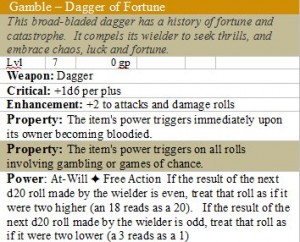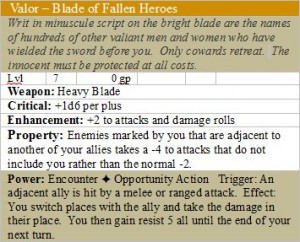Deviance #16 – Cursed Items
This one’s going to run a little long ’cause I have a lot to say. Just warning you. Also, I’m selling my PHB3, $25 (which includes shipping) anywhere in the States. International listeners, eh, we’ll talk. Shoot me an email if you’re interested.
But now let’s take a peek at cursed items. Back in earlier editions, a cursed item was basically a “gotcha;” the big middle finger from behind the DM screen. It looked like something cool until you found out it actually sucked – and then you couldn’t get rid of it or it killed you. Great for gritty “realism”, not so good for heroic storytelling. For the purposes of 4E, I think of three basic types of curses.
First, minor curses – downfalls or oddities that are fairly situational – are ok to spring on your PCs without warning most of the time. The 3rd edition version of the Backbiter Spear (though I would avoid the 1st or 2nd edition versions), an Elven Cloak that fails to work for dwarves, armor that makes you vulnerable to radiant damage while in direct sunlight and a healing potion that also turns you Smurf blue for the rest of the day aren’t going to be game-breaking and perfectly legitimate as surprise curses. If your curse is mildly annoying, easy to circumvent or simply played for laughs, you can put it on any magic item that seems feasible and have the curse only identified when it actually occurs for the first time.
I prefer the second class of curses, ones that a player can put aside if they want, but are tempted to endure for the sake of power. Think about cursed items in literature. Everyone in LotR knew what the One Ring was and exactly how it worked. Elric could put Stormbringer down any time he wanted to, but he didn’t. These are the kinds of cursed items you want to mimic for the bulk of your game. A necromancer’s wand that drains a healing surge the first time it is used each day but adds an extra d6 of damage to critical hits is going to entice players to keep using it so that the loss of the healing surge doesn’t go to waste. The dagger of a famous traitor that adds another die of Sneak Attack once per day, but only after it is has struck one of it’s wielder’s allies (for base d6 damage dice, of course) is another good option. When creating an item like this, you’re asking your players to make a sort of bet. They ante with an upfront cost and then hope their bet pays off. This keeps the curse in play and the item in the character’s hand without forcing it with a “this item can not be discarded without a Remove Curse” entry. Also consider a mechanic like the one in the Summoning Wizard’s class article from Dragon 385 where if you don’t use the item or do what it wants you to do, it “misbehaves.” Imagine a set of boots that give +2 speed but if the character doesn’t move at least half their speed on a turn, the boots will move them their full speed at the end of their turn – and never somewhere helpful! Characters who try to identify these types of items should probably at least know vaguely that something is wrong ahead of time if not the full nature of the curse.
If, however you are the sort of sadistic DM that needs to inflict horrible punishments and crippling infirmities on your PCs just because you can (and for whatever reason you’re still playing 4E), then let your players be heroic in their suckiness. That is, let them choose to be cursed, take up the weapon that can’t be sheathed or wear the ring that can’t be removed. But who’s going to choose being cursed? I bet the paladin in your party would rather be unable to put down the immensely powerful but soul-draining cursed sword rather than let it fall into the hands of the villain. I bet the party psion already hears enough voices in her head that she could deal with a supernatural possession better than that 10-year old orphan over there. And I bet the party rogue is willing to be mute or take a -4 to all saving throws if it will help him get through the dungeon to the hoard of gold at the end. You can hand your PCs the 2nd edition Backbiter Spear in 4th edition so long as they know how it works in advance and it will be an interesting, compelling item when used. A good DM will know the characters’ (and players’) motivations and can use them to convince said characters to willingly take on horrifying curses.
Since first writing this, Quinn Murphy of the At-Will Blog has put up a list of his own cursed items and I strongly encourage you to go read it. He and I had a lengthy discussion on the topic and turns out we have vastly different design philosophies. Namely, his items are far more complex and harder to get rid of, but you get the fun stuff before the curse hits. Mine are simpler and not so permanent but I make you deal with the curse first before you get the fun stuff. It’s all a matter of taste really. I have posted my versions of his two cursed items – Gamble and Valor – below.
Before I end, I should probably address the save-or-die curses. Some are fairly simple to import, like the Necklace of Strangulation. In 2nd edition this item dealt 6 points of damage per round to its wearer until their corpse fully decomposes, removable only with a wish or miracle! For 4E, you would probably want to give three saves, assisted by Heal checks, to prevent death so that it works more like a petrifying gaze attack. Don’t put these in every treaure chest, but once or twice per Tier, something similar could be quite a fun surprise! The scarab of death which after being worn for at least 10 minutes suddenly insta-kills … not so much. It’s just not the right fit for the heroic genre. Leave it be.
September 10, 2010 No Comments


